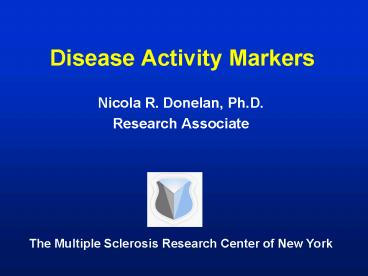Disease Activity Markers - PowerPoint PPT Presentation
1 / 19
Title: Disease Activity Markers
1
Disease Activity Markers
- Nicola R. Donelan, Ph.D.
- Research Associate
The Multiple Sclerosis Research Center of New York
2
Disease activity markers (biomarkers) in MS
Biomarkers are defined as biological molecules
that act as indicators of physiologic state and
also of change during a disease process
- Diagnosis of MS and identification of disease
stages and subcategories - Prediction of onset and disease course
- May help in elucidating disease mechanisms
- Treatment selection and improved prognosis of
treatment success - The evaluation of novel therapeutics
3
Panel of activity markers currently measured in
the lab
- Fetuin-A
- Nitric oxide
- Osteopontin
- Matrix metalloproteinase-9 (MMP-9) and Tissue
inhibitors of metalloproteinase1 and 2 (TIMP-1,
-2)
4
Active vs Inactive
- Absence of the 3 criteria for active diagnosis
- More than 1 relapse in the past year
- Increased disability - change in EDSS score
- Increase in MRI lesion load and/or presence of
gadolinium enhancing lesions
5
Fetuin-A (Alpha2 HS-glycoprotein)
- 95 liver-derived protein
- Modulator of the immune response
- TGFB antagonist
- Regulation of matrix metalloproteinases
- Regulator of insulin activity
- Involved in osteogenesis and bone resorption
6
Fetuin-A is a marker of disease activity in MS
- Levels of Fetuin-A are significantly elevated in
the CSF of patients with active disease - Increased levels of Fetuin-A are found in areas
of demyelination in autopsy MS brain tissue - Increased levels of Fetuin-A are found in areas
of demyelination in the animal model of MS
7
Fetuin-A levels are Elevated in the CSF of
Active vs Inactive MS
800 ng/ml
SP-MS
PP-MS
RR-MS
8
Fetuin-A is Elevated in Areas of Demyelination
9
Fetuin-A is also Elevated in Areas of
Demyelination in the animal model of MS
10
Measuring Treatment Efficacy
- Clinical examination
- Magnetic Resonance Imaging (MRI)
- Analysis of a panel of disease activity markers
in CSF
11
Concentration of Fetuin-A in the CSF before and
after 6 months of Tysabri treatment
Concentration of Fetuin-A (ng/ml)
Patients 1-4
12
Nitric Oxide (NO)
- Nitric oxide is produced by macrophages and
neutrophils as part of the immune response - Important mediator/messenger in neuroprotection,
neurotransmission, memory, and synaptic
plasticity under physiological conditions - Implicated as a potential mediator of
microglia-dependent demyelination - High levels of NO in CSF may lead to toxic damage
of myelin and oligodendrocytes - Recent evidence suggests that nitric oxide is
also immunoregulatory and may suppresses the
function of activated proinflammatory macrophages
and T lymphocytes - High levels of NO in CSF have been associated
with activity and progression
of MS
13
Concentration of NO in the CSF before and after
6 months of Tysabri treatment
Concentration of Nitric Oxide (ng/ml)
Patients 1-4
14
Osteopontin (Opn)
- Early T cell-activation gene 1, enhances the
survival of activated T cells - Produced by immune and non-immune cells
including T cells, macrophages, NK cells,
endothelial cells, epithelial cells, astrocytes
and neurons - Inflammation (activates dendritic cells driving
pro-inflammatory response) - Bone remodeling
- Opn deficient mice are resistant to EAE
- Increased levels of Opn have been found in MS
patients with active disease
15
Concentration of Osteopontin in the CSF before
and after 6 months of Tysabri treatment
Concentration of Osteopontin (ng/ml)
Patients 1-4
16
Immune Cells found in
Cerebrospinal Fluid (CSF)
B cells
T cells
Typical Cellular Composition 60-80
lymphocytes Up to 30 monocytes/macrophages 2
Other cells (e.g.. Dendritic cells, NK cells)
17
Number of cells in the CSF before and after 6
months of Tysabri treatment
Number of cells in the CSF (cells/ml)
Patients 1-4
18
Summary
- The cellular content of the CSF crudely reflects
disease activity - Measuring protein levels of Fetuin-A, nitric
oxide and osteopontin in the CSF provide a
reliable indicator of disease activity in MS - Measuring this panel of disease activity markers
allows for improved treatment selection and
better prediction of treatment success
19
Acknowledgements
- Jacqueline Dinzey, B.A.
- Christina Poopatana, B.A.
- Mustapha Rammal, B.A.
- Qi Jian Yan, M.D., Ph.D.
- Soheli Chowdhury, Ph.D
- Saud Sadiq, M.D.
- Special thanks to the MSRCNY Board of Directors































